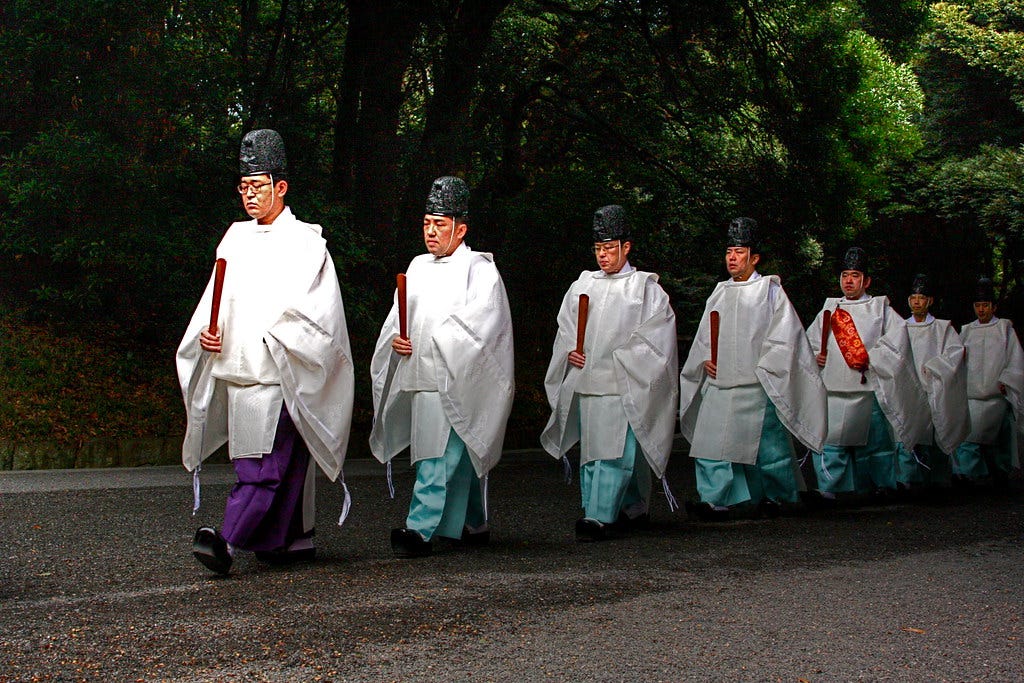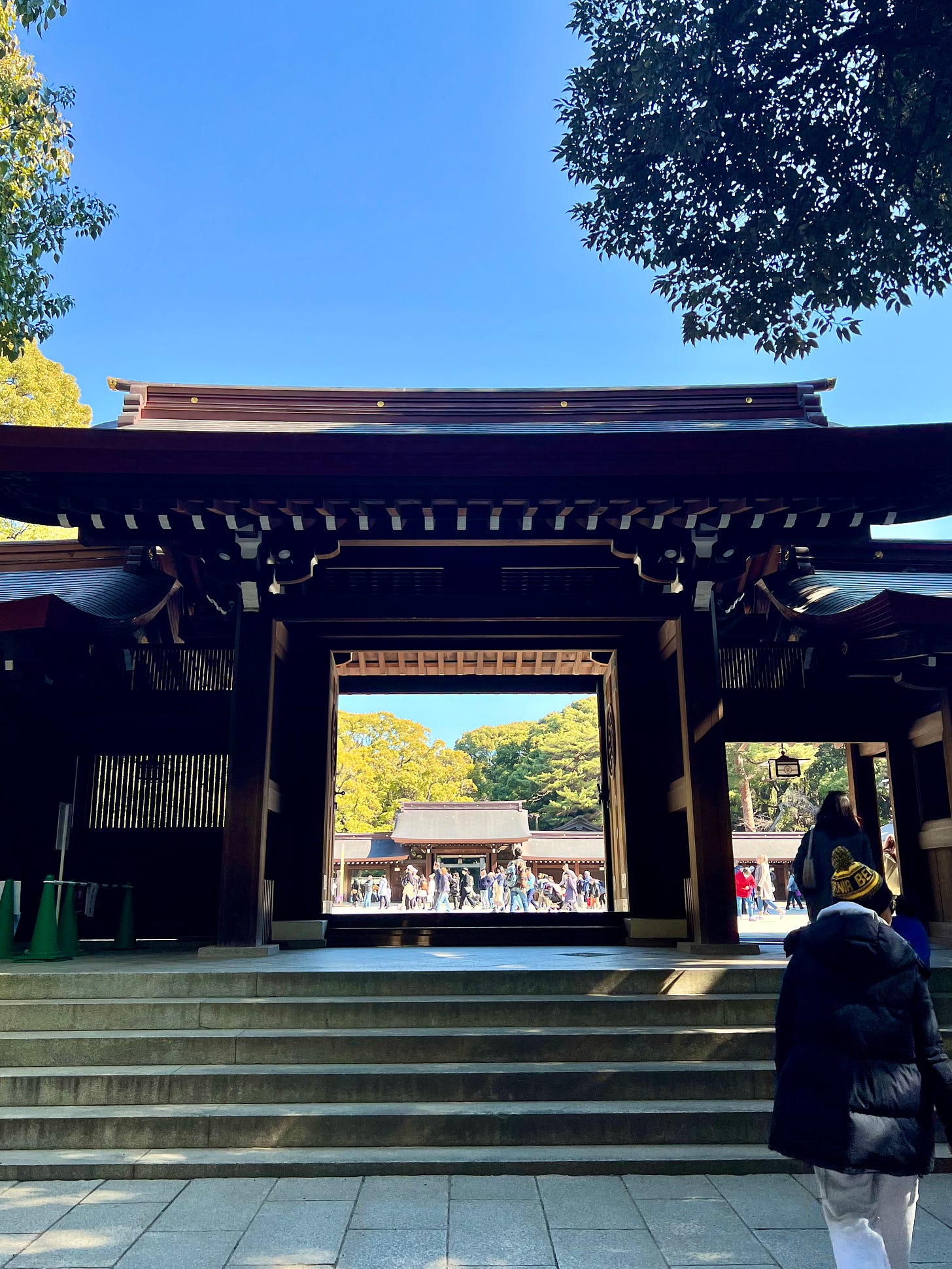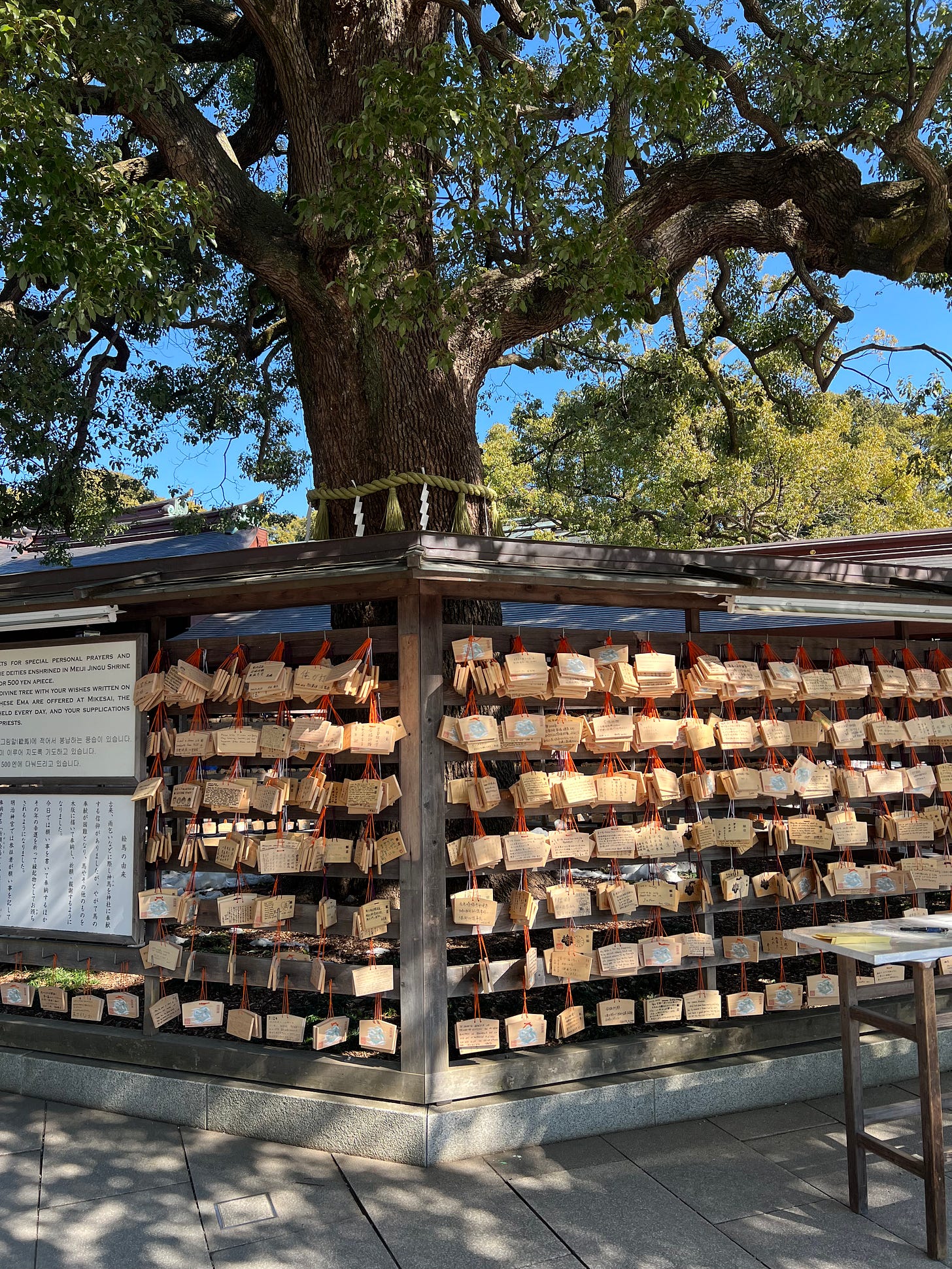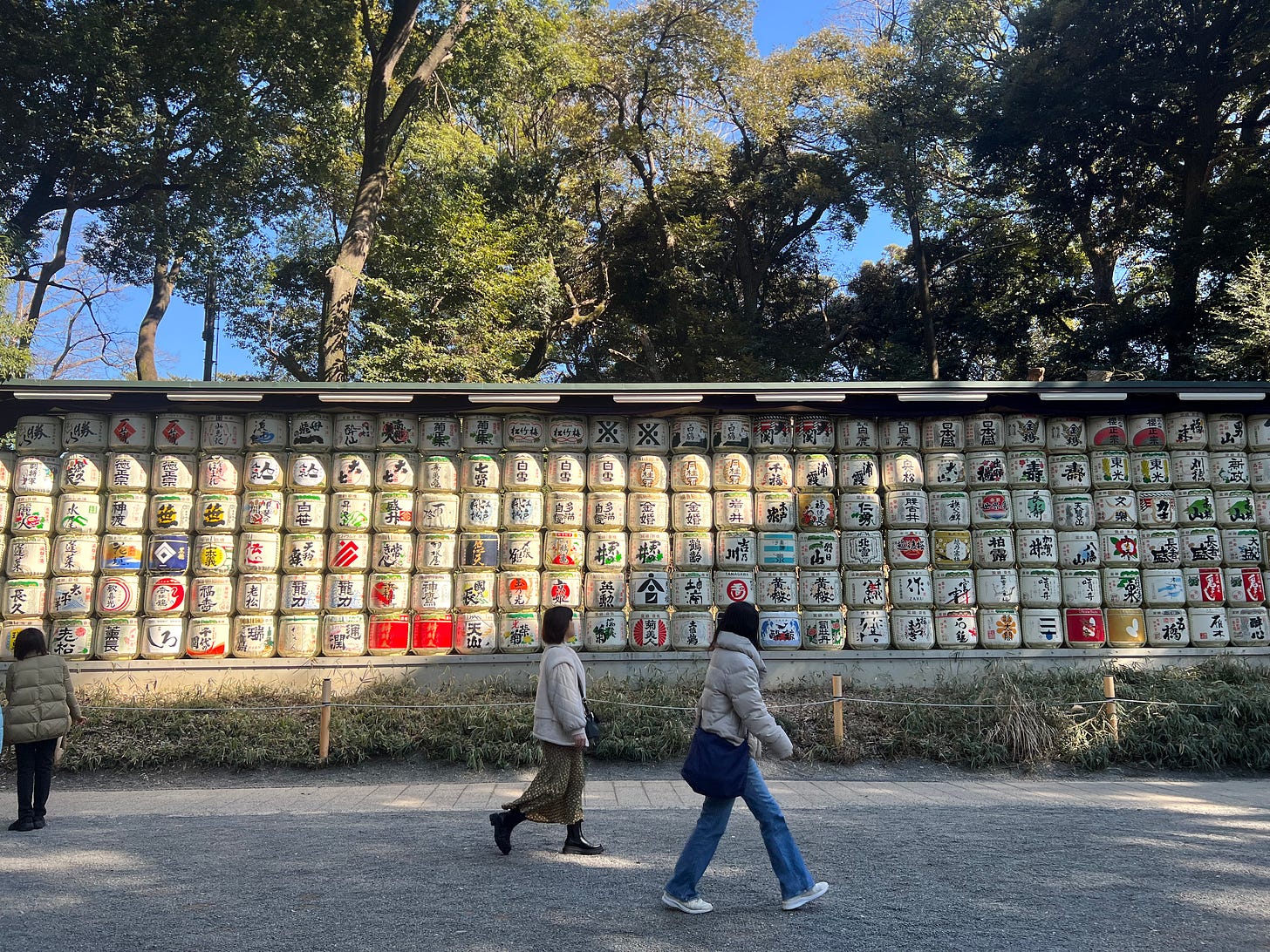Hi everyone! Today’s article focuses on Meiji Shrine, the biggest shrine in Tokyo. We’ll first explore the history through a quick, character-centered fictional story in Part I before delving into what the shrine is like today in Part II. Enjoy!
Part I: Meiji Shrine, 1920
The aroma of wet soil perfumes the air as you gently ease the oak sapling from its pot and plant it in soft soil. As you pack its roots with fertilizer, you’re reminded of your childhood on your family’s ancestral farm down in Yokohama.
Though starting a new life in Tokyo has allowed you to send money home and keep your three younger sisters fed during hard months, the nostalgia of feeling your hands caked with dirt stirs your longing for the countryside.
At least there, you didn’t feel so alien as you do now among the rushing crowds, the towering machinery in the railcar factory where you work, and the multistoried buildings with their hollow eyes.
You wipe the sweat dribbling down your chin and straighten your back before moving on to the next tree. All around you, young men and women labor with stooped backs, some planting trees while others carrying supplies to their fellow workers.
After Emperor Meiji’s passing seven years ago, the state commissioned a shrine to be built and a forest planted around his favorite iris garden. Thousands of youth, such as yourself, have already volunteered to work on the project, and thousands more will participate in the coming month. You’d volunteered to plant trees on your day off partly because you knew you’d be good at the job and partly because your parents respected his majesty.
In the distance, you spy construction workers dismantling the scaffold hugging the shrine’s palatial facade, their minuscule movements reminding you of a troupe of ants breaking down a rice ball.
Once the shrine is finished, your mother and father would want to visit Tokyo to pray to the emperor and empress’s spirit. The thought pulls your lips into a smile. The last time you’d seen them, your face was still smooth as a pebble. Now, it is studded with pimples and shaded with light stubble. You can hear your mother’s gravelly voice: “Bamboo grows fast, but our Shinji grows faster.”
A train shrieks not too far off—perhaps it is pulling into Shinbashi Station. You imagine a torrent of twiggy country boys with patched clothing pouring from its carriages into the bustling streets, their eyes aglow with the same hope that had propelled you to this city over a year ago.
You ease another oak tree from its pot, accidentally staining the cuff of your kimono with wet soil. Though the blue dye had faded to a cloudy gray long before you’d arrived in Tokyo, you can’t bring yourself to replace the only reminder of home you have left. Making a living in a city is not the same as making that city your home.
Your mind returns to the image of the train full of country boys. They will learn soon enough. Everyone does.
The train shrieks again, this time louder. Besides you, a worker with a sunburnt neck jokes, “The singing lady is early today.”
A few of his companions snigger as someone else exclaims, “Hope her sister is close behind.”
Something witty crosses your mind, but you hold your tongue, afraid to draw attention to yourself. Nearly all the field workers are youth volunteers like yourself, but being from the countryside, you naturally felt a little wary about the city natives.
If you tried to join their banter, would they accept you as one of their own or turn their nose at you like the other guys at the railcar factory? As you dig another hole, you watch the boy with the sunburnt neck furtively. He was speaking to the friend who’d made the sister joke.
“—silk is only going to get more profitable, so I’ve heard.”
His friend answered, “Maybe you should also consider starting a factory for western suits.”
“Their cut lacks refinement,” the boy replied.
“I wouldn’t ignore them. The emperor himself even wore suits.”
The boy smiled. “How about a different question—who should I hire in the future?”
“Maybe that farm boy over there?” His friend asks.
Dread settles in the pit of your stomach. You tilt your head to see if they’re talking about you, and sure enough, you see him jabbing a thumb in your direction.
The two boys double over with laughter when they catch you staring. Cheeks burning, you hunch your shoulders and go to the water station by the dirt path. There, a girl in a pink and yellow kimono hands you a wooden cup of cold water. You glance at her face, and she averts your eyes with a smile. The heat spreads from your face down to your neck. How much of the conversation did she and the other volunteers catch?
You watch the field of stooped figures as you sip your water. The land stretches like a neverending scroll sprinkled with tiny flakes of matcha. A thread of buildings and traffic have begun to appear along the northern edge of the field in the past few weeks.
From this distance, it looks like a mere smudge against the horizon that can be blown away with one breath, but you are not fooled. If the past twelve months have taught you anything, it’s that Tokyo is a city deeply dissatisfied with itself. It did not merely accept change. It hankered for it like a starved child. It’s seen the way Britain raped China, demanding reparations while pouring opium down its throat, and it is determined to avoid that fate at all costs.
A new age is dawning. From the meanest alley to the busiest market, nowhere in the city is safe from the scintillating rays of progress.
You think of your parents and sisters tending the earth as your ancestors have done for centuries. Surely they are far enough from Tokyo that the rays of progress will not burn them as well?
You take another swig of water and return to your post. The warmth of the soil softens your worries as you plant another tree. Though you might not live to see this area transform into a forest, you’re still comforted by the thought of future generations sheltering under its shade when they, too, need a break from the rays of progress.
Part II: Meiji Shrine, 2024
Last week, I visited Meiji Jingu, one of Tokyo’s most prominent Shinto shrines. Seated at the center of an artificial forest of 172 acres, the shrine is said to house the kami (spirit) of Emperor Meiji and Empress Shōken, who ruled during a time of pivotal economic and social reformation.
The Meiji Restoration (1868-1912) not only saw the emperor regain power after the fall of the military dictatorship government known as the Tokugawa Shogunate but also the abolishment of the feudal system, the centralization of the government, and the country’s transition from an agrarian to an industrial economy.
Though Emperor Meiji formally ordered these reforms, he was not intimately involved with their execution. Instead, he influenced the country’s attitude towards industrialization and Westernization in other ways, such as embracing foreign customs in his personal life and encouraging diplomatic relations with America and Europe. His popularity among the people, even after his death, resulted in the construction of the Meiji Shrine.
Gaping at the pantheon of trees lining the path, I approached the Torri gate marking the boundary between the mundane and sacred worlds. Sunlight filtered through the foliage, casting the Torri in a soft, green sheen that made the structure feel much older than 100 years.
Before entering the shrine, I stopped by a bamboo fountain to wash my hands and mouth, as is the custom in Shintoism. The water stung my palms, turning them pale as cream. I listened to the whisper of the wind in the leaves as I lifted the water to my mouth and thought about the thousands of hands that had come together to create this forest.
Before coming here, I had known that the surrounding forest was manmade. However, I didn’t realize that the trees had been donated from all over Japan and planted by volunteer youth until I picked up an information pamphlet at the entrance.
There’s something touching in knowing that each of the 100,000 trees that make up this forest had been carefully planted by people who, though they lived in a bygone era, were probably not so different from you or me: people who dreamed of a better future, who stressed about exams, who’d stumble home after a long day at work, people who visited friends on the weekends, who worried about putting food on the table, who daydreamed about what this forest will look like in a hundred years when their grandchildren and great-grandchildren walk the earth.
Despite being surrounded by photo-snapping tourists and glimpsing sleek office buildings through gaps in the trees, I felt like I had entered a liminal space in time. As I walked, I imagined seeing kimonos instead of jeans, frail saplings dotting an empty field instead of a forest, and a streak of squat buildings in the distance instead of skyscrapers.
I wondered what being one of the tree-planting youths would have been like. Would I have felt apprehensive about a future clouded with factory smoke? Or would I have welcomed the opportunities afforded by Japan’s rapid development? Either way, it would have been hard to overlook the irony of immortalizing the kami of an emperor who’d embraced Western values and championed industrialization in a Shinto shrine set in a forest.
However, from a different angle, such an ending to his fifty-year reign could be seen as more apt than ironic. No amount of promulgating modernization or embracing Western values could negate the fact that the emperor was still the head of Shintoism, Japan’s indigenous religion, and the symbol of national unity. His shrine commemorates his memory as much as it reminds people of Japanese resilience.
After passing through the front gate, I found myself in an expansive courtyard speckled with tourists. Two enormous camphor trees stood guard in the left corner, their trunks joined by a shimenawa rope binding them in marriage. Another stood to the right, its trunk boxed off by low walls where visitors can write their prayers on ema (wooden placards) and hang them around the tree.
A medley of languages rippled through the air—Japanese, English, Mandarin, German—as I made my way to the shrine. Worshippers streaked from the mouth of the shrine down the steps, each of them pinching a lucky five-cent coin.
I lingered on the side and watched as they tossed their coin into the offering box, bowed twice, clapped twice, and pressed their palms together in prayer. Some bowed their heads and then left shortly after. Others lingered for longer, their brows knit in concentration as they lifted their desires to the emperor’s kami.
Craning my neck, I glimpsed the inner courtyard that was off-limits to general visitors. Five men in business suits stood shoulder to shoulder before the honden (inner sanctuary) that housed the kami while a priest faced them, saying something inaudible.
BOOM.
BOOM.
BOOM.
I started, and so did many of the other onlookers. Following the sound, I wove through the crowd and arrived at the right side of the shrine. A priest was pounding two mallets against an enormous drum in the hallway just beyond the offering box.
Murmurs of intrigue stirred the air. A child pointed at the priest and asked a question in Japanese. After the first priest finished speaking, the five men bowed synchronously and departed the inner courtyard to the right.


The second priest pounded the drum one final time just as two friends lined up beside me and began rummaging through their wallets for spare change. They were young, probably in their mid-twenties, both males. One had spiky hair. The other had a round face with ruddy cheeks. He smiled as he pulled out a coin and said something that made his friend laugh.
I wondered what they would pray for. Healing for a family member? Acing a job interview? Finding “the one”? Reading the requests written on the ema earlier, I noticed that these were the most popular requests among visitors.
As a tourist, observing Shinto customs in person and learning about Shintoism these past couple of weeks has been fascinating. I especially appreciate the religion’s emphasis on respecting nature and living harmoniously with the natural world. As a Christian, watching people pray to an object of creation evoked mixed feelings.
Relationship is centric to prayer. When you pray, you’re invoking action or attention from a being higher than yourself through your relationship with that being. On your end, faith enables you to pray to something not physically manifest and still believe in the effectiveness of your prayer.
However, faith is only one of the requisite factors for prayer to succeed. The object of worship must also be able to hear you, empathize with you, care about you, love you, and have the means to act on your behalf. But what if that object of worship does not have the capacity to have a relationship with you, love you, or care about you?
I glanced at the figures scribbling their wishes on the ema by the camphor tree before slipping out the gate. The mixed feelings return but not as strongly as before.
I will continue contemplating Shintoism for the rest of this trip. Compared to Christianity, it’s a strikingly decentralized religion with no sacred texts nor clear cut morals. For those reasons, I find it refreshing—as refreshing as cool water running through your fingers.
My time at Meiji Shrine ended with a stroll past the wall of Sake Barrels that greets visitors taking the Harajuku exit. Believed to bring people closer to the gods, drinking sake has always played an integral part in Shintoism.
One Shinto myth describes the storm god Susanoo rescuing a maiden from an eight-headed dragon by distracting it with sake. The drink is also presented as offerings at shrines to secure blessings for harvests, health, and business (such is the case with this wall of barrels). In traditional Shinto weddings, the bride and groom drink from three nuptial cups three times to bring their marriage good luck.
Stepping back to take a picture, I found the mosaic of Japanese characters combined with images of mountains, cherry blossoms, and other natural scenery quite dazzling. It’s not something you’d find anywhere in America, and as someone seeking novelty, I appreciated how it reminded me just how far from home I really am.
As I wound farther and farther from the shrine, the sound of rustling leaves and burbling streams gave way to rumbling traffic. Emerging from Meji Shrine felt like falling through a rack of heavy fur coats and returning to the real world. It’s a bit disappointing to find that this haven of green doesn’t extend forever, that bills and pollution and commutes still exist.
Squinting against the afternoon sun, I admired how the malls and businesses glistened like dominoes in the sunlight. The light turned green at the intersection, and I flowed with the stream of pedestrians into one of Tokyo’s most prominent shopping districts.
Crepes stuffed with cream and ice cream beckoned from display windows. Banners adorned with anime figures and Mt. Fuji clip art smiled down from shop entrances. People brushed past, their wrists weighed down by shopping bags. The frenetic need to consume permeated the air, and within minutes, I forgot what it was like to shelter in the shade of the forest.
Imagining this place as a collection of squat buildings felt surreal. If someone from a hundred years ago—let’s say a youth who’d volunteered to plant trees around the shrine—were to visit this district today, what would he feel? Awe at the sheer size and energy of the city? Grief at the erosion of tradition in favor of modernization?
As I picked my way down the main street, I pictured a young boy of about sixteen or seventeen staring from the strip of buildings to the forest. He was clad in a faded blue kimono made of rough cloth; his sleeves rolled up to reveal arms as tan as clay.
But no matter how long he gaped at the miracles of modernity, his pupils continued reflecting a bygone time: workers stooped in a field of tree saplings while a thread of low buildings wavered like a mirage in the background. A train whistled not too far off. He looked toward the horizon, longing for the simplicity of childhood while simultaneously basking in the rays of progress.
I paused before a 7-eleven to etch his features into my mind. Perhaps I’ll write about him when I return home—the boy from a bygone era who feels apprehensive about the era to come.
Chat with me :)
Have you ever visited Tokyo? If so, what were some of your favorite places?
Do you know much about Shintoism or is this your first time learning about it?
Can you relate to the youth from the story who feels apprehensive about the effects of urbanization and technology?
Feel free to share any feedback you have!












Thank you for the wonderful description of a place I may never visit (although now I may put it on my bucket list). A real treat, your descriptions never disappoint, "I felt like I had entered a liminal space in time."
I'm going to go off on a tangent on this reply, however. I noticed in the first section, you wrote in 2nd person, "You did this... you did that..." I encounter that a lot in multi-path adventure fiction. I know it's not your style, but keep an eye out for my next post where I will write about that in some detail.
Even though I personally try to avoid the second person perspective in my multi-path adventure writing, your use of it made me think you might want to try your hand at it one day.
I have been to Japan in 2019, and my favorite place in Tokyo is Ueno Park! I have been to Meiji jingu and it is a beautiful place, thank you for sharing with us your experience there!